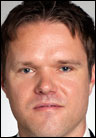Residents at German nursing home Haus Désirée have greater freedom of movement thanks to a real-time location system (RTLS) that offers employees a view into each resident’s location as he or she travels about the facility. The RTLS solution utilizes Ekahau hardware and HealthCarion‘s software platform to keep nursing-home personnel appraised regarding the locations of residents and other staff members, and to respond to a call for a nurse—all of which is tracked and stored in the facility’s back-end system.
The solution, installed three months ago, consists of Ekahau Wi-Fi-based RFID wristbands and badges and IR beacons, as well as Zyxel Wi-Fi nodes that receive the unique ID number and location of every Ekahau wristband or badge at regular intervals as the wearers move about the facility.
The nursing home had been searching for nurse-call technology to replace an outdated system that it was using to communicate with 15 or so staff members working onsite. It selected HealthCarion’s Wi-Fi-based solution not only to transmit messages to nurses, but also to track the locations of residents and receive that location data in the event that a resident requires assistance or wanders away.
A total of 20 Zyxel Wi-Fi nodes were installed throughout the building. Each of the facility’s 50 residents wears a waterproof Ekahau T301w wristband tag on his or her wrist or ankle, which includes a call button that can be pressed in order to summon assistance. The tag transmits its unique ID number at regular intervals via a 2.4 GHz signal conforming to the IEEE 802.11 Wi-Fi standard. The tags’ signals are received by any Wi-Fi nodes within range. HealthCarion also installed 75 Ekahau LB2 infrared (IR) beacons that transmit, via IR, their own unique ID number. When a wristband receives a beacon’s IR signal, it forwards that beacon’s ID, along with its own identifier.
The data is received by Ekahau’s positioning engine software on its RTLS Controller, which links the location data and ID number and then forwards that information to HealthCarion’s Patient Location Guard (PLG) software, residing on the nursing home’s back-end system, which determines the appropriate response to that data, such as sending a message to specific staff members. The PLG software stores location information, as well as sending transmissions to nurses if the resident has pressed the nurse-call button. It can also determine which workers should receive that message. Once a nurse responds to the patient’s call, he or she can press the call button on the patient’s tag once more. The alert is then discontinued in the software, and the event is stored, according to Christian Schulze, HealthCarion’s managing partner of strategy and sales.Each nurse wears an Ekahau T301BD tag on a lanyard containing an LCD screen to receive text messages. In this case, the badge’s unique ID number is not linked to an individual, but simply indicates that the person wearing the badge is a staff member. In that way, employees need not feel as if their own performance is being evaluated by management as they move about the building. When a nurse call is sent to specific staff badges, a light flashes, the device vibrates, and a text message appears on the screen, indicating where help is required, as well as by which resident.
The software also provides protection from wandering. If a resident enters an area in which he or she is not permitted, such as an exit or a medical procedure room, an alert is issued to authorized staff members, enabling them to respond immediately.
By maintaining a record of events, Haus Désirée’s management can also review incidents after the fact. For example, Schulze says, if a resident tells family members that he or she has been using the wristband to call for help, but has not been receiving responses from the staff, the family members can ask to see the records, and thereby determine when their loved one pressed the nurse-call buttons, when he or she received responses and how quickly this occurred.
According to Schulze, the entire system was installed in a matter of approximately two weeks, including the installation of the Wi-Fi nodes and IR beacons. Wi-Fi nodes were mounted throughout the building, providing 100 percent coverage, while the IR beacons were placed within resident rooms, bathrooms and medical procedure or common areas.
With the RFID technology in place, the nursing home can now provide its residents with greater freedom of movement than they would have had prior to its installation, since employees can be assured that they will receive an alert if an individual wanders into an unauthorized area.


